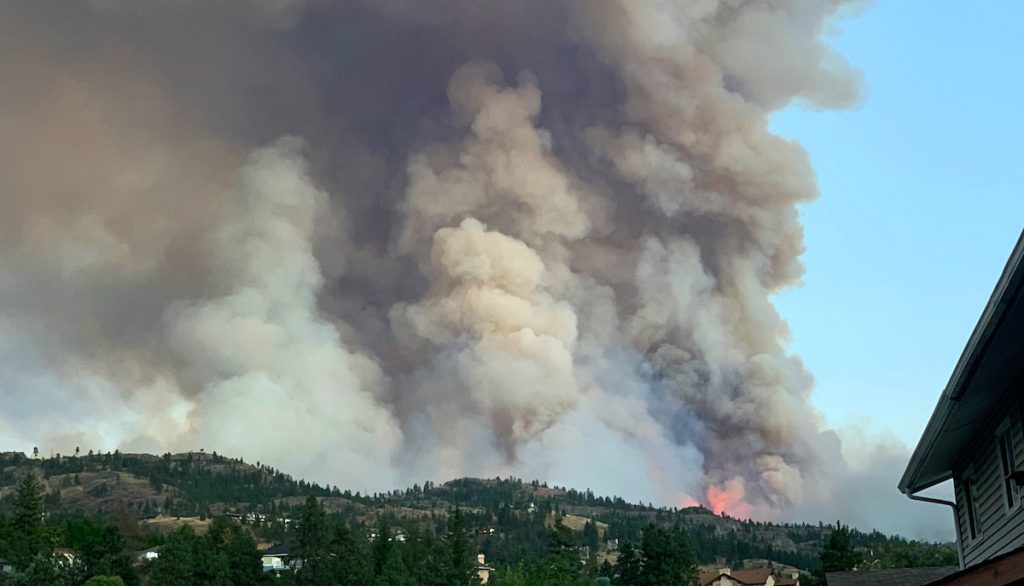
image: Christie Mountain (Penticton BC) fire, August 18 2020
BC thought it was out of the woods when it came to forest fires this summer of 2020. There was hardly spark through June, July, and early August. Then all of a sudden the first major wildfire of the season ignited along Christie Mountain in Penticton (pictured above) on August 18th. This fire was quickly followed by two additional blazes in the interior which continue to burn (at press).
Households in BC are typically prepared fur such events. But wildfire preparedness looks a lot different this summer as we’re in the thick of a much greater crisis – COVID 19. Adjustments need to be made to account for both concerns, which is why we’re updating our guide to preparing to respond to an approaching forest fire. Please read below, right away.
3 Updated Tips to Preparing for BC Forest Fires During the Summer of COVID 19
1. Plan for a Safe Place to Stay
Households in at-risk regions may face evacuation orders. In the past you may have been able to head for a friend or family member’s home at the drop of a hat but that is no longer an option unless they already happen to be in your COVID “social bubble”. Since finding a place to stay has become a lot more complicated you need to plan ahead.
Reach out to friends and family who live nearby (but not in the same fire zone) and gauge your respective health risks and comfort levels should you need to come and stay with them for a few days or longer. In some cases you or your hosts may prefer to section-off an area of their house to minimize contact with one another. At the very least come to an agreement now so that you don’t have to put them in an uncomfortable position when calling upon them with little to no notice.
If you don’t have any social or familial options then you must map out other accommodation alternatives. Price hotels and motels in the area (outside of the fire zone) so that you have options should one or more be fully booked – it is the summer in BC after all. In addition, plan alternative routes to get to these accommodations because forest fires in the province often occur near highway transportation routes.
If these options have become exhausted, contact your local municipality to inquire about accommodation options for households during evacuation orders – which typically include community centers, school gymnasiums, and the like. Also inquire about what they are doing to keep households safe and separated while being temporarily housed in a community facility. If you don’t like what you hear you can at least add important health and sanitation items to your evacuation emergency kit – which we discuss further below.
2. Update Your Emergency Evacuation Kit (and Pack It Now)
An essential element in any wildfire preparedness plan is the assembly of a basic emergency kit that will allow your family to evacuate and be self sufficient for at least 72 hours. This kit needs to be portable and easily accessible. We have already detailed exactly what you need to add to a traditional household emergency kit right here.
While you may have already compiled or purchased ready-made kits from a local retailer or community resource center, they are missing key “ingredients” to account for COVID 19. Your evacuation kit needs to be updated to include the following:
-
- Medical grade surgical latex gloves for each member of the family
- Medical grade surgical masks and reusable PPE face shields for each member of the family
- Hand sanitizer that is at least 60% alcohol based (please ensure it is not on the government recall list)
- Antibacterial soap
- Additional linens to ensure that you don’t use those provided by others (friends, family, or community)
Given that wildfires spread extremely fast evacuation orders may come quickly and unexpectedly. Please pack your update emergency kit as soon as you finish this article.
3. Driving Away from Impacted Areas
You must not only be prepared to leave your home if evacuation orders are issued, you must be prepared to drive away along routes that may been impacted by an approaching fire. Follow our 5-step guide to staying safe when driving near forest fires, but please note that road travel has also changed amidst COVID 19. Park Insurance has also provided a guide to summer (read: forest fire season) highway driving amidst COVID 19 which you can review here.
Follow Traditional Best Practices
The above tips are an addendum to traditional forest fire preparedness best practices to account for COVID 19. You must still follow the guides which we have already prepared to make sure your home and household remain safe during this seasonal threat. Please review the following: